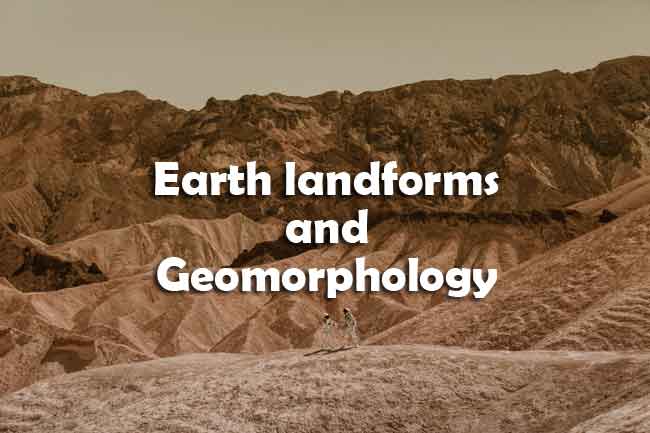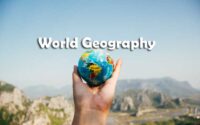Earth landforms and Geomorphology Questions and Answers
Earth landforms and Geomorphology Questions and Answers Papers pdf will be available here for download. Therefore, all the contenders can make use of this chance and start to download the Earth landforms and Geomorphology Solved Question Papers.

Because by solving the Earth landforms and Geomorphology Objective Model Papers you can improve your knowledge. Also, check for download the Earth landforms and Geomorphology MCQ Papers with Solutions from the link provided below. The Earth landforms and Geomorphology Quiz helps you to prepare well for the exam topic wise and obtain very good marks.
Therefore, go through this post thoroughly and download the Earth landforms and Geomorphology Last Year Question Papers. All these questions on Earth landforms and Geomorphology are collected from previous year papers and compiled by us.
Questions and Answers on Earth landforms and Geomorphology
1. Which one of the following is igneous rock ?
(A) Limestone
(B) Granite
(C) Marble
(D) Slate
2. How many minutes for each degree of longitude does the local time of any place vary from the Greenwich time ?
(A) Two minutes
(B) Four minutes
(C) Six minutes
(D) Eight minutes
3. The tropical grassland is called
(A) Pampas
(B) Lianas
(C) Savanah
(D) Veld
4. The topography of plateau is ideal for
(A) Cultivation
(B) Forestry
(C) Mining
(D) generation of hydro power
5. Which of the following statements is correct ?
(A) Lava and magma both have gas
(B) Neither the lava nor the magma has gas
(C) Magma has gas while lava has no gas
(D) Lava has gas while magma has no gas
6. Which one of the following is the example of sedimentary rocks ?
(A) Loess
(B) Basalt
(C) Granite
(D) Gabbro
7. Mica is found in which one of the following pairs of rocks ?
(A) Slate- Sandstone
(B) Schist-Gneiss
(C) Limestone-Sandstone
(D) Shale- Limestone
8. The Mohorovicic (Moho) Discontinuity separates
(A) Outer core and Mantle
(B) Inner and Outer core
(C) Sima and Nife
(D) Crust and Mantle
9. Suppose if we measure the time lapse between the two Sunsets by sitting in the beach, from this we can estimate
(A) The distance between the sun and the earth
(B) The depth of the ocean
(C) The radius of the earth
(D) The radius of the sun
10. What is the International Date Line ?
(A) It is the equator
(B) It is the 0° longitude
(C) It is the 90° east longitude
(D) It is the 180° longitude
11. Earthquake is caused by
(A) disturbance of earth surface
(B) adjustment of layers of earth’s crust
(C) breakage of rock system
(D) upliftment of rocks
12. The highest grade and best quality coal is
(A) Lignite
(B) Peat
(C) Bituminous
(D) Anthracite
13. River erosion is at its greatest where river’s
(A) depth is more
(B) breadth is more
(C) flow is fast
(D) gradient is more
14. In which of the following is the Great Barrier Reef located ?
(A) Coral Sea
(B) Solomon Sea
(C) Bismarck Sea
(D) Arafura Sea
15. The term ‘epicentre’ is associated with
(A) Earthquakes
(B) Volcanoes
(C) Cyclones
(D) Landslides
16. What is the scale used for measuring the intensity of the earthquake?
(A) Richter scale
(B) Metric scale
(C) Centigrade scale
(D) Newton’s scale
17. Equator represents
(A) line joining North and South poles
(B) imaginary line passing round the Earth midway between North & South poles
(C) a belt (ring) around the planet Saturn
(D) axis of rotation of Earth
18. The acceleration due to gravity at the equator
(A) is less than that at the poles
(B) is greater than that at the poles
(C) is equal to that at the poles
(D) does not depend on the earth’s centripetal acceleration
19. The ‘Pacific Ring of Fire’ is associated with
(A) oil well fires
(B) thermal power station
(C) volcanoes and earthquakes
(D) forest fires
20. Which one of the following rivers forms an estuary ?
(A) Ganga
(B) Tapti
(C) Godavari
(D) Mahanadi
| Physical Geography | Atmosphere |
| Bio Geography | Earth landform |
| Soil Geography | Universe and Solar System |
| Hydrosphere |
21. How much of the Earth’s land surface is desert ?
(A) 1/10th
(B) 1/5th
(C) 1/3rd
(D) 1/6th
22. What percentage of world’s freshwater is stored as glacial ice ?
(A) 50%
(B) 10%
(C) 70%
(D) 30%
23. The approximate circumference of the Earth is
(A) 13,000 km
(B) 20,000 km
(C) 25,000 km
(D) 30,000 km
24. Desertification can be checked by
(A) plugging gullies
(B) checking over-grazing
(C) contour ploughing
(D) forming shelter belts
25. In an iceberg floating in the sea, out of 10 parts of its mass, how much will remain above the surface of the water?
(A) 1 part
(B) 2 parts
(C) 4 parts
(D) 6 parts
26. A day is added when one crosses
(A) the equator from south to north
(B) 180 degree longitude from east to west
(C) the equator from north to south
(D) 180 degree longitude from west to east
27. When does the moon come between the Sun and earth?
(A) Lunar eclipse
(B) Solar eclipse
(C) Sidereal day
(D) Full moon day
28. The latitude of a place is expressed by its angular distance in relation to—
(A) Equator
(B) South Pole
(C) Axis of the Earth
(D) North Pole
29. Hanging Valley is very common in
(A) high mountains
(B) sub-Arctic region
(C) glaciated areas
(D) coastal belt
30. The word ‘dendritic’ is associated with—
(A) Wind
(B) Waves
(C) Rivers
(D) glaciers
31. When the earth is at the maximum distance from the Sun, it is called
(A) Aphelion
(B) Perihelion
(C) Equinox
(D) Sidereal
32. The scale that measures the intensity of earthquakes is called as
(A) Vernier scale
(B) Richter scale
(C) Beaufort scale
(D) Diagonal scale
33. The main source of usable water on the Earth is
(A) Oceans
(B) Rivers
(C) Underground water
(D) Precipitation
34. Which of the following rivers lies in a rift valley?
(A) Luni
(B) Chambal
(C) Sone
(D) Tapti
35. What is meant by Isthmus?
(A) Mouth of a river where it joins the sea
(B) Narrow strip of water dividing two land masses
(C) Narrow strip of land dividing two oceans
(D) Narrow strip of land connecting two large areas of land
36. Natural embankments found on upper valley sides are-known as
(A) high banks
(B) levees
(C) bunds
(D) ridge
37. Volcanoes are scattered
(A) all over the world
(B) only along the coasts
(C) on the islands
(D) mainly along young fold mountains
38. Which of the following minerals are required for smelting iron ore?
(A) Limestone and gypsum
(B) Manganese and limestone
(C) Limestone and coal
(D) Gypsum and coal
39. Basaltic lava is found in the
(A) Deccan Trap
(B) Himalayas
(C) Indo-Gangetic Plain
(D) North-Eastern Hills
40. Which one of the following types of erosion is responsible for the formation of Chambal Ravines ?
(A) Splash
(B) Sheet
(C) Rill
(D) Gully
41. Consider the following geological phenomena :
I. Development of a fault
II. Movement along a fault
III. Impact produced by a volcanic eruption
IV. Folding of rocks
Which of the above causes earthquakes?
(A) I, II and III
(B) II and IV
(C) I, III and IV
(D) I to IV
42. Shale is metamorphosed into which of the following rocks?
(A) Graphite
(B) Gneiss
(C) Marble
(D) Slate
43. Where are the hot deserts generally found ?
(A) On the eastern margins of the Tropics
(B) On the western margins of the Tropics
(C) Nearer the Equator
(D) In the middle of the Continents
44. Why are winters more severe in Southern Hemisphere than in Northern Hemisphere?
(A) Earth is titled towards the sun in the Northern Hemisphere
(B) Northern Hemisphere receives more sunlight
(C) Because of more iceberg activity in Southern Hemisphere
(D) Southern Hemisphere is less inhabited
45. Marble is the metamorphosed form of
(A) Shale
(B) Basalt
(C) Sandstone
(D) Limestone
46. The highest mountain peak of the Himalayas is situated in—
(A) India
(B) Tibet
(C) Nepal
(D) China
47. Metamorphic rocks originate from—
(A) igneous rocks
(B) sedimentary rocks
(C) both igneous and sedimentary rocks
(D) None of these
48. The term ‘epicentre’ is associated with—
(A) Earthquake
(B) Folding
(C) Faulting
(D) earth’s interior
49. Dolomite is a/an
(A) Sedimentary rock
(B) Plutonic rock
(C) Igneous rock
(D) Metamorphic rock
50. A geyser is a spring which
(A) throws water continuously
(B) throws water intermittently
(C) throws water and steam at regular intervals
(D) throws only steam



